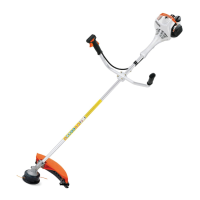FS 55, FS 55 C, FS 55 R, FS 55 RC
English
6
It may be carried only in a horizontal
position. Grip the shaft in a manner that
the machine is balanced horizontally.
Keep the hot muffler away from your
body and the cutting attachment behind
you.
Fuel
Your STIHL power tool uses an oil-
gasoline mixture for fuel (see the
chapter on "Fuel" of your instruction
manual).
Fueling Instructions
In order to reduce the risk of burns and
other personal injury from escaping gas
vapor and fumes, remove the fuel filler
cap on your power tool carefully so as to
allow any pressure build-up in the tank
to release slowly. Never remove the fuel
filler cap while the engine is running.
Select bare ground for fueling and move
at least 10 feet (3 m) from the fueling
spot before starting the engine. Wipe off
any spilled fuel before starting your
machine.
Different models may be equipped with
different fuel caps.
Toolless cap with grip
To do this with this STIHL cap, raise the
grip on the top of the cap until it is upright
at a 90° angle. Insert the cap in the fuel
tank opening with the raised positioning
Warning!
Always shut off the engine and make
sure the cutting attachment has stopped
before putting a trimmer / brushcutter
down. When transporting it in a vehicle,
properly secure it to prevent turnover,
fuel spillage and damage to the unit.
STIHL recommends that you keep
metal blades covered with the transport
guard (optional accessory).
Warning!
Gasoline is an extremely
flammable fuel. If spilled
and ignited by a spark or
other ignition source, it
can cause fire and seri-
ous burn injury or
property damage. Use extreme caution
when handling gasoline or fuel mix. Do
not smoke or bring any fire or flame near
the fuel or the power tool. Note that
combustible fuel vapor may escape
from the fuel system.
Warning!
To reduce the risk of serious injury from
burns, never attempt to refuel the unit
until it has been completely removed
from the operator.
Warning!
Fuel your power tool in well-ventilated
areas, outdoors. Always shut off the
engine and allow it to cool before refu-
eling. Gasoline vapor pressure may
build up inside the fuel tank depending
on the fuel used, the weather conditions
and the tank venting system.
Warning!
Check for fuel leakage
while refueling and dur-
ing operation. If fuel
leakage is found, do not
start or run the engine
until the leak is fixed and
any spilled fuel has been wiped away.
Take care not to get fuel on your cloth-
ing. If this happens, change your
clothing immediately.
Warning!
In order to reduce the risk of fuel spill-
age and fire from an improperly
tightened fuel cap, correctly position
and tighten the fuel cap in the fuel tank
opening.

